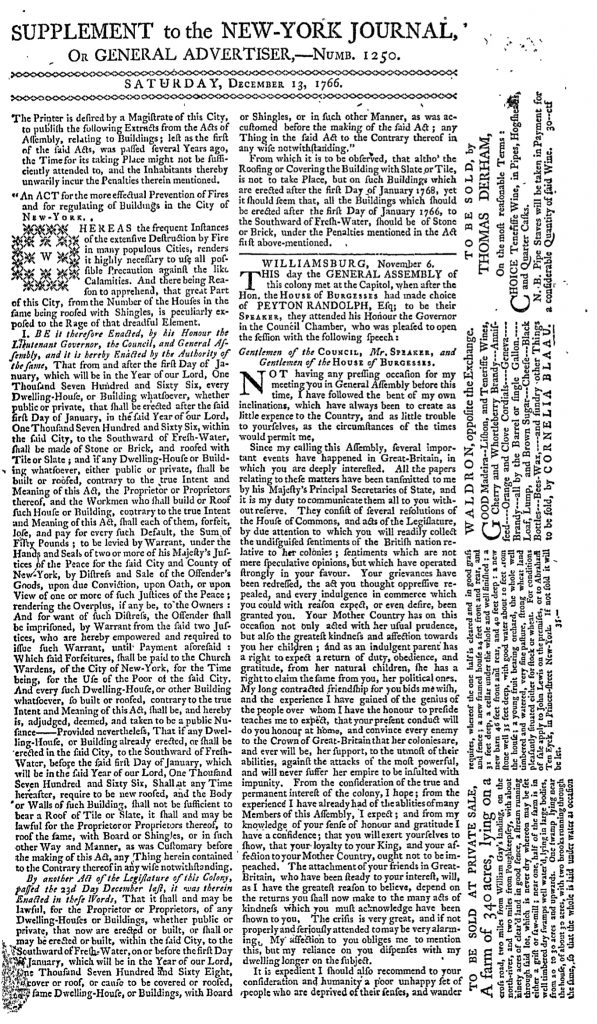What was advertised in a colonial American newspaper 250 years ago this week?

“TO BE SOLD, by THOMAS DERHAM, … CHOICE Teneriffe Wine.”
Thomas Derham’s advertisement for “CHOICE Teneriffe Wine” occupied a rather unique position on the first page of the Supplement to the New-York Journal, printed two days after that week’s regular issue of December 11. It appeared in the upper right corner, but the entire advertisement had been rotated ninety degrees counterclockwise, such that it was printed perpendicularly to the two columns that comprised the majority of the news and advertising on the page. A narrow column of text – actually four columns, each rotated ninety degrees counterclockwise – appeared on the right side of the page.

When I first encountered this striking image when consulting the digitized reproductions of eighteenth-century newspaper made available via Readex, I suspected that I knew how to explain it, having examined something similar in the New-Hampshire Gazette earlier this year. It looked as though the supplement had been printed on a smaller broadsheet than the regular issue, reducing the number of columns, but the industrious printer rotated some of the text to squeeze in as much news and advertising as possible. There was no way to know for certain that this was the case, however, without examining original copies of the supplement and standard issues of the New-York Journal from 1766. Readex does not supply metadata about the measurements of broadsheets and columns, nor do I fault the company for not providing this information since it would be prohibitively expensive to collect and code. This is an instance in which working with digital surrogates hides information about the sources that would have been apparent from just a glance at the original. For the record, unless a ruler appeared in every frame of the microfilm reproduction of the New-York Journal, I would have encountered the same difficulty. The shortcoming is not specific to digitization but rather to any sort of surrogate that removes the researcher from interacting with the text in its material form.
Besides, as much as I appreciate the convenience of working with so many digitized newspapers as I pursue this project, sometimes it’s nice to have an excuse for working with the originals. Upon examining the American Antiquarian Society’s copy of the New-York Journal I learned that my assumption was indeed correct. John Holt used a smaller sheet for the supplement (8 & ½ inches by 14 inches rather than 10 inches by 15 & ½ inches). He maintained the same column width, 2 & 7/8 inches, but did not have sufficient space for a third column, at least not unless he rotated some of the text in order to make it fit on the narrower page. Each of the four columns in the “bonus” column measured 2 & 7/8 inches. All of the text from those miniature, rotated columns appeared in a previous issue of the New-York Journal. Holt did not need to set new type; he simply moved around advertisements that had been set already.
Did readers take special notice of Thomas Derham’s advertisement because of its rather unique placement on the page? Possibly, but whatever additional interest it may have generated cannot reasonably be attributed to any sort of intentional effort to produce an innovative layout to draw attention to advertising. Instead, the printer was practical and pragmatic when putting together the December 13 supplement. Examining the original allows me to make such claims with confidence, while the digital surrogate alone could not resolve my questions or point me in the direct of the best possible interpretation to explain the interesting placement of Derham’s advertisement.
